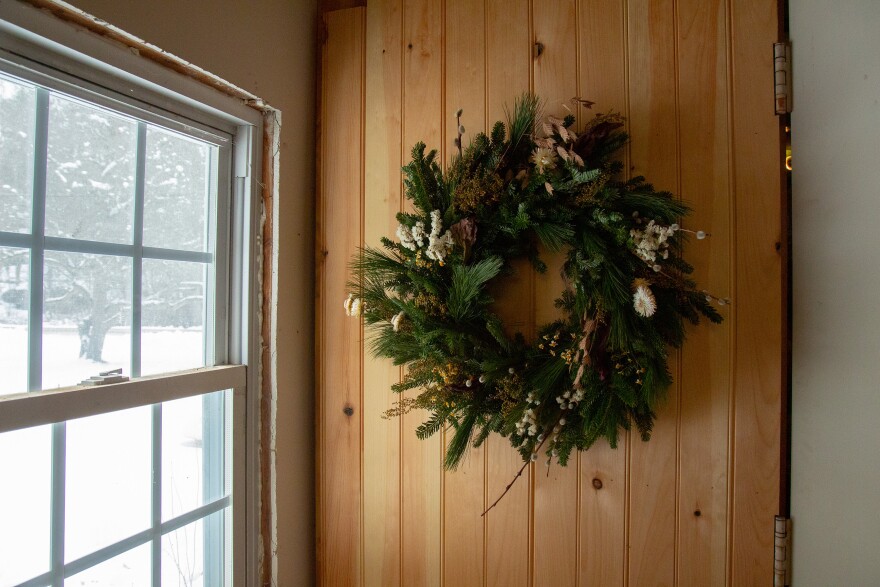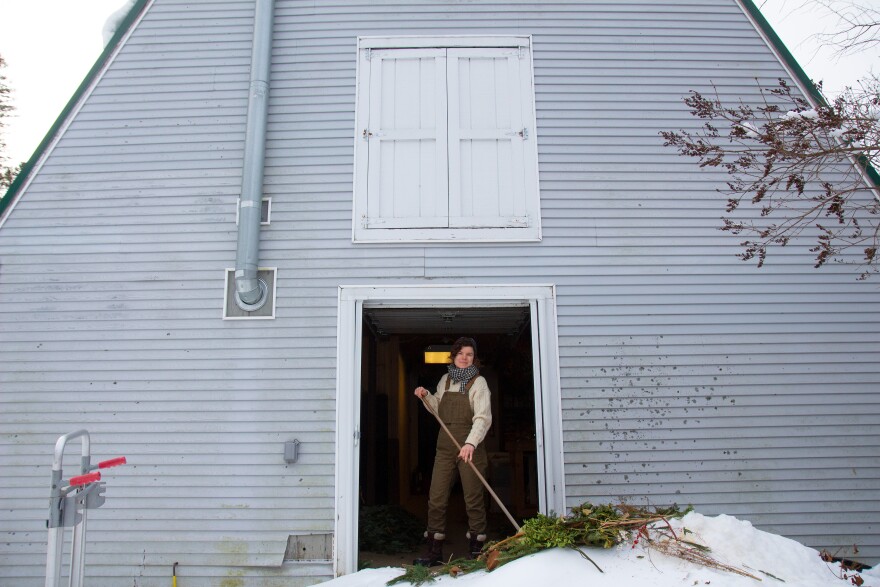Vermont’s wreath industry goes way back. It’s a way for farmers and other people who work close to the land to make extra income when most crops are done growing.
But wreath makers in Vermont are noticing some changes in the climate, and some think a little more science could help them adapt.
Florist Kelsey Adams runs West Lane Flowers in Colchester. In the barn there, dried flowers hang from the beams. But during the holiday season, Adams trades blooms for branches.
During the last two months of the year, they’ll make between 50 and 150 wreaths.
On a recent visit, Adams prepped a workstation that was covered with flowers.
“Apparently I cut just the right amount of pine,” they said. “I love the smell of sweet Annie, it’s really just magic. It’s such a humble flower.”
Standing over a wooden work bench with thick leather gloves, Adams gathered small bunches of white pine, Fraser fir and balsam, sometimes adding a sprig of dried pussy willow or feverfew.
Next, Adams pressed the bundle onto a circular wire frame, with clamps, locked into a simple wreath-making machine.

Using a foot pedal, they punched the clamp down, over the twig-end of the bundle, locking it in place. They worked around the wreath this way until the full circle was covered with brush and flowers.
“I could put a bow on it, or it could just be beautiful, like this,” Adams said.
Every fall, they buy 50-pound bundles of trimmed Fraser and balsam fir boughs — called “tips” — from nearby Christmas tree growers.
This is pretty common for wreath makers. Some people do the trimming, other people do the wreath making and decorating. Other businesses purchase wreaths from small-scale makers and sell them at scale.
The trimming is where Rayon Watson’s Springfield business, New England Christmas Tree Services, comes in.
“We’ll go to a farm and we’ll basal prune a big tree for them, tie the brush up and they’ll have a client come in to pick it up, weigh it, and then sell it as well,” Watson said.
Farms across Vermont, New Hampshire and Massachusetts hire his teams to cut brush, prune trees and harvest for them.
“It all comes together,” he said. “Either you use [the brush] for yourself, or you’re selling it to somebody.”
Watson expanded his business this year and now does some wreath making himself. He grew up farming, which is where he learned to cut brush. And he hopes to start his own someday in southern Vermont.

For lots of Christmas tree farmers, selling bulk brush for wreaths is good revenue. They have to prune their trees anyway, and making income off the tips adds some extra cash, which means more stability.
But the window to make and sell wreaths is a short one, and getting even shorter. This year, it was extra short.
Peggy Day Gibson owns Northeast Kingdom Balsam. She and her family have been selling wreaths in West Glover since 1977.
“We look for three hard frosts to set the needles of the balsam,” Day Gibson said “And even then, we don’t want to start cutting until Halloween weekend.”
Those frosts in the fall set the needles and keep them from falling off the boughs.
But falls in Vermont are shrinking thanks to climate change. And the signals farmers have relied on to know when to harvest are changing.
For example, Day Gibson said: “I have a friend, also, who says that the brush is ready when the leaves fall off the raspberries.”

But this year, the raspberries in Glover were still hanging on to their leaves by Thanksgiving.
The average temperature in Vermont this November was more than 5 degrees Fahrenheit warmer than the average for the last century. All that left wreath makers really nervous.
And then, things seemed to turn out OK. Other than some early season losses, most of the needles stayed on the wreaths.
Day Gibson says knowing why balsam needles set would help her and others adapt to a changing climate and save wreath makers a lot of worry.
Ali Kosiba used to be Vermont’s state climate forester. Now she’s a forestry professor at the University of Vermont. She says the trees wreath makers rely on are very much impacted by climate change.
“Balsam fir is sort of the poster child of a species in our state that is not forecasted to do well in a warmer climate,” she said.
Kosiba says scientists don't quite have an answer to Peggy’s question.
What they do know is that trees set their needles as part of getting ready for winter. They also make a kind of antifreeze in their cells, and the daylight — but also the temperature — tell them when to do this.
Kosiba says this process is really complicated.
“They have to go through, like, a lot of physiological changes, because they have to withstand really, really cold temperatures,” she said. “I mean, negative 20 degrees Fahrenheit.”
Kosiba says one thing farmers can do right now to make their businesses more resilient to warmer and more variable temperatures is to plant saplings from a variety of seed sources — even within the same species. She says individual fir trees may set their needles at different times.

Back in Colchester, Kelsey Adams says it was a challenging season, but things worked out this year.
“I was OK, because I bought from people who are up in the mountains,” Adams said. “The couple of things I was harvesting from around here, I just had to wait for.”
Still, Adams says if they had to source all their tips from their own farm in Colchester, they simply wouldn’t have made it in time for the holiday rush.
Have questions, comments or tips? Send us a message or get in touch with reporter Abagael Giles @AbagaelGiles.





